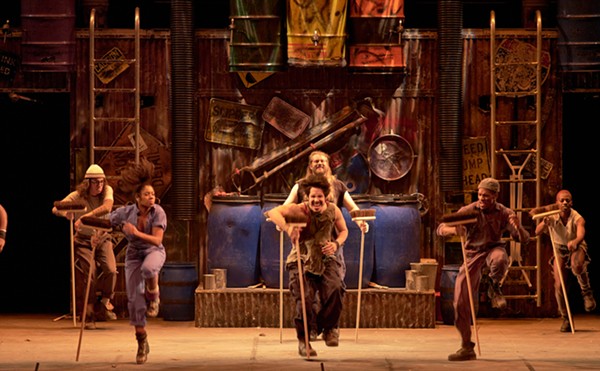After 25 years, William Busta has established himself as one of the region's most celebrated and respected art dealers. This Friday evening from 5 to 9 p.m., his gallery in Midtown hosts an opening reception for its three latest exhibitions, featuring sculptures by Kate Budd and paintings by Paul Yanko and Hildur Ásgeirsdóttir Jónsson.
Kate Budd has been teaching sculpture at the University of Akron's Myers School of Art since 1998. She was born in Nairobi, Kenya. She received her B.A. from Gray's School of Art in Aberdeen, Scotland and her MFA in sculpture from Southern Illinois University at Carbondale. Her exhibition, Use Unknown, Possibly Ritual, features what Budd refers to as her "liminal objects."
"Liminal objects are found at the threshold of changing conditions, partly woven from biological need, but also weathered and encrusted by time and climate, finally resembling and shading into the long dreams of human culture," explains gallery owner William Busta. "Such things are the subjects of Kate Budd's enigmatic, myth-inflected sculpture."
"Ideas that feed my work include desire, disease, fecundity and constraint. I seek archetypal forms, creating hybrids that take emotional cues from the human body and possess the singularity of fruit, shells and roots," says Budd. "Visiting Scottish museums as a child, I was fascinated by ancient Pictish stone spheres. Oddly functional in appearance, they were accompanied by the phrase 'use unknown, possibly ritual.' Old beyond my comprehension, these small forms had presence and mystery and gave me a sense of the power objects can have."
"Her exhibit consists of very small, talisman-like works of art fashioned from wax and coated in graphite, or cast in bronze," adds Busta.
None of these measures more than 3 inches, and any could fit easily in the hand or pocket. One round, undulating waxen circlet titled "Ruff" looks like a sort of faerie collar; others, like "Purse" and "Sea Bean (bronzed)," or 'Dark Cowrie,' seem like miniature containers made from nuts or shells, carryalls produced by a vanished, magical race. Most are ribbed or nubbed or pierced, touchable (at least one wants to touch them) — something to be kept and rediscovered from time to time.
"I begin by carving solid blocks of wax; creating a positive by the removal of material is both magical and challenging," explains Budd. "Close attention is paid to the possibilities revealed as I go; working intuitively, I learn what the piece is by making it. The wax is a pleasure to work, cool and sensuous, translucent and responsive. Pod-like forms have sawn off surfaces that reference human interventions such as dissection. Tiny glass beads are sprinkled across an egg wall. By wrapping and pinning, polishing and embellishing, I explore the human desire for artifice and decoration and our unwillingness to accept the world 'as is.' Exploring the Darwinian notion that the fittest survive, I try to understand what makes an object desirable."
Paul Yanko is originally from Youngstown, but he's been teaching painting at the South Carolina Governor's School for the Arts and Humanities in Greenville, S.C. He received his BFA from Cleveland Institute of Art before earning his MFA at Kent State University. His work is reminiscent of Modernist geometric abstraction, a genre of which our region has a rich legacy.
"The densely layered compositions characteristic of my painting are reflective of a desire to reconcile formal painterly concerns with an interest in creating process-derived imagery," explains Yanko. "I remain equally influenced by emblems of Modernist geometric abstraction in addition to the characteristically intense, saturated hues found in commercial sign painting and toy construction sets.
"I develop my paintings systematically through an additive process of layering acrylic paint mixed with acrylic mediums onto masked areas. I initially establish sets of vertical and horizontal bands, applied to either a square or rectangular format, with function as an armature on which subsequent color shapes are layered. As I paint, I allow shapes to shift in registration in order to reveal varying amounts of underlying color."
Hildur Ásgeirsdóttir Jónsson was born in Iceland, but received both her BFA and MFA from Kent State. She returns to Iceland every summer for about two months to explore its beautiful landscape. The photos she brings back become the inspiration for her unique silk weavings.
"I look for shapes and colors, textures, lines that seem to be interacting in some interesting ways," says Jónsson. "There's always an element of surprise, and I think that's absolutely essential to the work to be successful. I guess what I'm after is recreating the overwhelming feeling I have in the landscape, the energy I feel in the earth. I try to distill that and bring it out. In a raw landscape like that, you're so much closer to the source. Hopefully that life and energy translates into the work."
Her process plays an active role in the product, with the two parts of the loom shifting her original imagery slightly. The result is hazy forms with indefinite boundaries. "When it goes through the loom, there is a little bit of shifting," adds Jónsson. "The shifting gives me that kind of feathery look. Plus, the way I paint, wet on wet, is also giving me that kind of feathery, atmospheric appearance."
Kate Budd will be in the gallery on Saturday, Oct. 25 from 2 to 4 p.m. to discuss her work. The exhibitions are on display through Saturday, Nov. 15.
William Busta Gallery
2731 Prospect Ave., 216-298-9071,williambustagallery.com.












